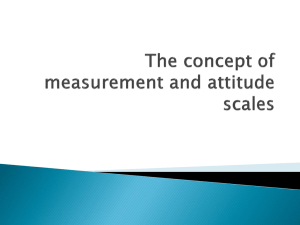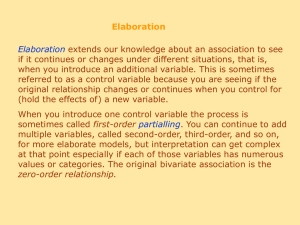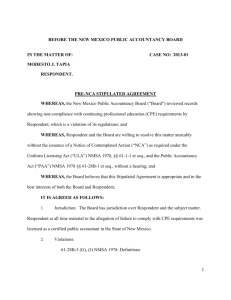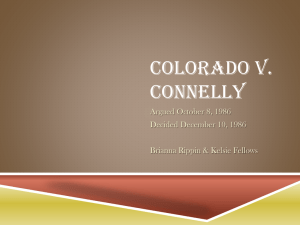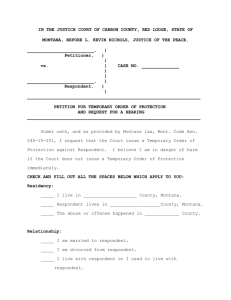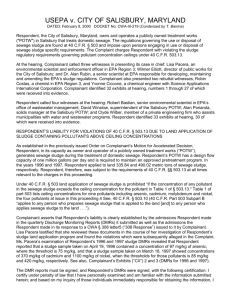Pollution Prevention Projects - Florida Department of Environmental
advertisement
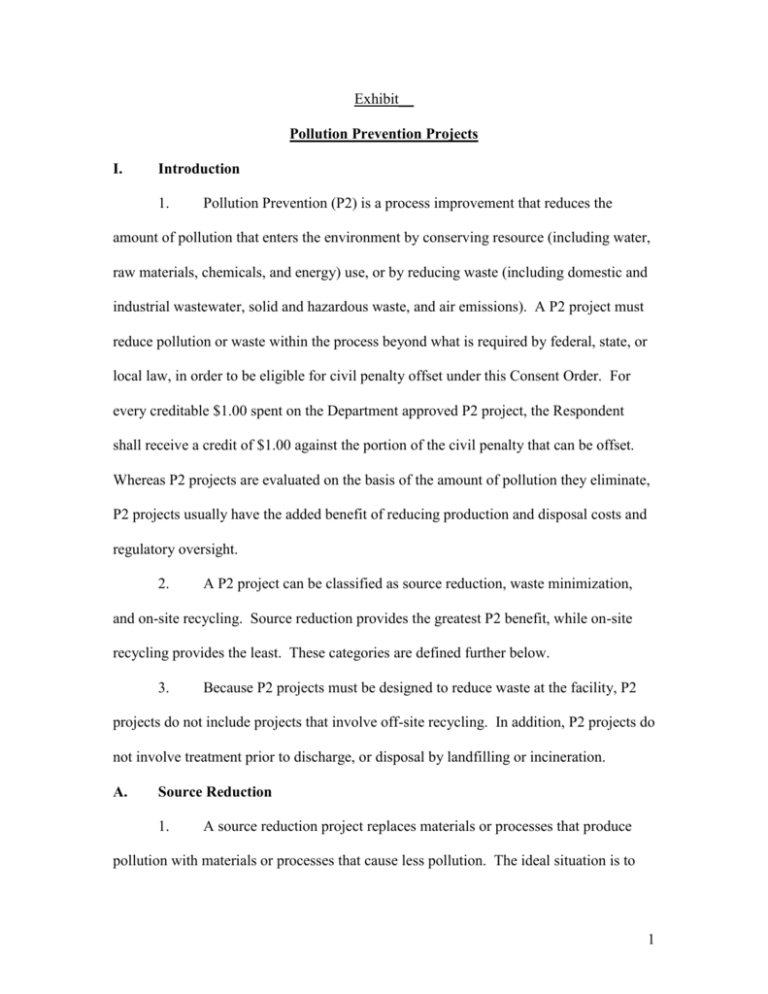
Exhibit__ Pollution Prevention Projects I. Introduction 1. Pollution Prevention (P2) is a process improvement that reduces the amount of pollution that enters the environment by conserving resource (including water, raw materials, chemicals, and energy) use, or by reducing waste (including domestic and industrial wastewater, solid and hazardous waste, and air emissions). A P2 project must reduce pollution or waste within the process beyond what is required by federal, state, or local law, in order to be eligible for civil penalty offset under this Consent Order. For every creditable $1.00 spent on the Department approved P2 project, the Respondent shall receive a credit of $1.00 against the portion of the civil penalty that can be offset. Whereas P2 projects are evaluated on the basis of the amount of pollution they eliminate, P2 projects usually have the added benefit of reducing production and disposal costs and regulatory oversight. 2. A P2 project can be classified as source reduction, waste minimization, and on-site recycling. Source reduction provides the greatest P2 benefit, while on-site recycling provides the least. These categories are defined further below. 3. Because P2 projects must be designed to reduce waste at the facility, P2 projects do not include projects that involve off-site recycling. In addition, P2 projects do not involve treatment prior to discharge, or disposal by landfilling or incineration. A. Source Reduction 1. A source reduction project replaces materials or processes that produce pollution with materials or processes that cause less pollution. The ideal situation is to 1 produce goods or services with no pollution. Source reduction has the most benefit for the environment among the P2 project options and usually requires the greatest change in the production process. B. Waste Minimization 1. A waste minimization project reduces the generation of unusable by- products (air emissions, wastewater, or solid or liquid wastes). Waste minimization strategies involve reducing resource use and minimizing waste generation on site that result in a net decrease in the release of chemicals to the environment. C. On-Site Recycling 1. On-site recycling projects reuse materials that are the source of pollution. Process materials are reused directly or indirectly in the original or some other process within the facility. II. The P2 Project Approval Process 1. In order to adequately evaluate the P2 project options, the Department must understand the facility processes, material use, waste streams, options available, projects proposed, and estimated waste and cost savings. 2. The P2 project is typically implemented in a five-step process. First, the Respondent must prepare and obtain the approval of a P2 Opportunity Assessment (Assessment). Second, the Respondent must prepare and obtain the approval of a P2 Project Plan (Project Plan) based upon the findings in the Assessment. Third, the Respondent must construct or implement the approved Project Plan. Fourth, the Respondent must submit a P2 Final Report (Final Report) to the Department that summarizes the P2 modifications or improvements, benefits, and allowable costs. 2 Finally, the Department approves or disapproves the offset of the penalty. All of these steps and the timeframes are discussed in detail below. A. The P2 Opportunity Assessment 1. Within 30 days of the effective date of this Consent Order, the Respondent shall submit an Assessment to the Department for review and approval. The Assessment provides the basis for identifying, comparing, and evaluating P2 opportunities at the facility. The Assessment should be divided into two sections: a. An audit of current facility practices and their associated waste streams, that shall identify where improvements can be made and provide a baseline for measuring changes, and b. A complete evaluation of all available options for improvement regardless of their feasibility, a feasibility determination and an environmental determination of acceptable options. These options are then evaluated for economic and technical practicality, and environmental benefit. 2. The Assessment shall include a table by which all the processes can be compared. The table shall include brief descriptions of the processes, P2 options, resources consumed, waste streams, and P2 benefits. The table shall be supplemented by more in-depth descriptions that will allow the Department to evaluate the P2 options for each process. Because the P2 project will be evaluated by the amount of pollutants removed from the environment, the comparative units shall be in weight per unit time or volume per unit time. Concentrations are not appropriate units. The time unit used to calculate the amount of pollutants removed should be sufficiently large to average out abnormalities. All waste should be considered, including solid and hazardous wastes, 3 wastewater, and air emissions. Raw materials, water, chemicals, and energy use should be similarly examined. 3. The Current Facility Practices section of the Assessment shall include: a. Location and name of the facility and a brief description of what is done there; b. Contact information for personnel who provided information, analysis, background data, or expertise for the Assessment; c. Identification and description of processes or operations producing waste streams; d. Mass balances that identify and quantify input materials for each process, materials consumed during each process, and waste streams produced from each process; e. Simple flow charts or diagrams for each process; and f. Supporting documentation such as waste profile sheets. 4. The Improvement Options Evaluation section of the Assessment shall include a comprehensive list of the following P2 options and their corresponding considerations for each process that produces a waste stream: a. Process Elimination - Can an acceptable product be achieved without this process? b. Process Substitution - Can an acceptable product be achieved with a cleaner process? c. Input Material Substitution - Can a less polluting chemical or substance be used in the process? d. Waste Reduction - Can the process be run with less waste? 4 e. In-process Recycling/Reuse - Can used process materials be used instead of virgin materials in the same process? f. Out-process Recycling/Reuse - Can used process materials, instead of virgin materials, be reused in another process within the facility? g. Waste Segregation - Will the segregation of wastes result in any usable waste products? h. Improved Maintenance - Can facility operations be run more efficiently with improved equipment maintenance? i. Improved Operational Procedures and/or Scheduling - Will improving facility operational procedures and/or scheduling reduce the generation of waste? j. Improved Equipment Layout, Piping and or Automation - Will upgrading facility process equipment reduce the generation of waste? 5. The Pollution Prevention Opportunity Assessment section of the Assessment shall also consider and record all P2 options. This consideration shall include: a. A description of each process; b. A description of any P2 option considered for each process; c. The technical feasibility of each P2 option; d. The approximate cost of implementing process modifications or changes; e. A quantitative description of the materials and wastes to be reduced; f. A quantitative description of any waste streams that will increase; g. Other benefits such as economic return; and 5 h. Supporting documentation such as Material Safety data Sheets (MSDSs), material purchasing and use records, waste stream analytical test results, recycling, treatment or disposal records, or vendor information on proposed new equipment. 6. The Department will review the Assessment and either approve or disapprove with comments. If the Department disapproves the Assessment, the Respondent shall resubmit the Assessment that is responsive to the comments. If after one re-submittal the Assessment is not approved or if the Respondent does not resubmit, the Respondent shall pay the balance of the allowable amount of the civil penalty in accordance with the Consent Order. B. P2 Project Plan 1. Within 60 days of approval of the Assessment, the Respondent shall submit a detailed P2 Project Plan based on the approved Assessment, particularly section II, Pollution Prevention Opportunity Assessment. The Project Plan shall describe in detail the current operation of the particular process that will be part of the P2 Project. The process description will aid in the P2 Project’s design and provide a benchmark for measuring the P2 Project’s success. The Project Plan shall include four sections: background information, project description, environmental and economic benefits, and a schedule for implementation. 2. The Background section of the Project Plan shall include the following: a. Flow diagram of the process; b. Mass balance of the process; and c. Current operating costs including material procurement, maintenance, operation, utilities, and waste disposal, costs. 6 3. The Project Description section of the Project Plan shall include the following: a. Description of process modification; b. Any modifications to the flow diagram; c. Mass balance for the new process; d. Itemized costs of implementing the project including the design, capital equipment, installation, testing, training, and total project cost; e. Costs of operating and maintaining the project once it is complete; and f. Documentation that supports the costs such as vendor literature and price quotes, research, endorsements: 4. The Environmental and Economic Benefits section of the Project Plan shall describe in detail for each material use and waste stream eliminated or reduced, and for each material use and waste stream created or increased: a. Type of material or waste; b. Mass (weight or volume) reduction/increase in materials and wastes per unit time; c. Mass (weight or volume) reduction/increase in materials and wastes per unit of production; d. Method of material re-use/waste management; e. Expected financial incentives and monetary gains; f. Supporting documentation. 5. The Schedule for Implementation section of the Project Plan shall contain a brief discussion of the steps necessary to implement the project and expected dates of 7 completion. The schedule shall include milestones, anticipated problems and options, and the project completion date. The implementation should take no longer than six months from approval of the Project Plan. 6. The Department will review the Project Plan and either approve or disapprove with comments. If the Department disapproves the Project Plan, the Respondent shall resubmit a Project Plan that is responsive to the comments. If after one re-submittal the Project Plan is not approved or if the Respondent does not resubmit, the Respondent shall pay the balance of the allowable amount of the civil penalty in accordance with the Consent Order. C. Implementation of the P2 Project Plan 1. Within 30 days of approval of the P2 Project Plan, the Respondent shall begin implementation of the P2 Project in accordance with the approved schedule. D. Progress and Final Reports 1. Within 90 days of approval of the Project Plan, the Respondent shall submit a progress report to the Department that describes the Respondent's progress in implementing the P2 Project and meeting the requirements in the Project Plan and includes a list of equipment ordered, purchased, and/or installed. 2. Within 180 days of approval of the Project Plan, the Respondent shall submit to the Department a Final Report that includes the following: a. An update on the information required in the Environmental and Economic Benefits section of Project Plan; b. A description of the methods used to quantify wastes; 8 c. An expense report, receipts, and other documents itemizing costs expended on preparing and implementing the project, which are described in section E below. 3. The Department shall review the Final Report and determine: a. Whether the project has been implemented in accordance with the approved P2 Project Plan; and b. Which expenses apply toward pollution prevention credits. 4. If the P2 Project Plan is approved by the Department and properly implemented, a $1.00 pollution prevention credit for each $1.00 spent on applicable costs will be applied against the portion of the civil penalty that can be offset. E. Final Accounting and Civil Penalty Offset 1. The following costs are allowable to offset the allowable amount of the civil penalty: a. Preparation of the P2 Project; b. Design of the P2 Project; c. Installation of equipment for the P2 Project; d. Construction of the P2 Project; e. Testing of the P2 Project; f. Training of staff concerning the implementation of the P2 Project; and g. Capital equipment needed for the P2 Project. 2. The following costs shall not apply toward P2 credit: a. Costs incurred in conducting a waste audit; b. Maintenance and operation costs involved in implementing the P2 Project; c. Monitoring and reporting costs; 9 d. Salaries of employees who perform their job duties; e. Costs expended to bring the facility into compliance with current law, rules and regulations; f. Costs associated with a P2 Project that is not implemented; g. Costs associated with a P2 Project that has not been approved by the Department; and h. Legal costs. 3. If any balance remains after the entire P2 credit is applied to the allowable portion of the civil penalty, Respondent shall pay the difference within 30 days of written notification by the Department to the Respondent that the balance is due. 4. The Department may terminate the P2 Project at any time during the development or implementation of it, if the Respondent fails to comply with the requirements in this document, act in good faith in preparing and implementing the project, or develop and implement the P2 Project in a timely manner. The Respondent may terminate the P2 Project at any time during its development or implementation. 5. If the P2 Project is terminated for any reason, Respondent shall pay the full balance of the allowable portion of the civil penalty within 30 days of written demand by the Department. 6. Any public statement, oral or written, in print, film, or other media, made by Respondent making reference to the P2 Project Plan shall include the following language, “This project was undertaken in connection with the Florida Department of Environmental Protection for violations of Florida’s environmental laws.” 10

